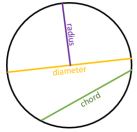General Information
Benchmark Instructional Guide
Connecting Benchmarks/Horizontal Alignment
Terms from the K-12 Glossary
- Circumference
- Constant of Proportionality
- Diameter
- Pi (π)
- Proportional Relationship
Vertical Alignment
Previous Benchmarks
Next Benchmarks
Purpose and Instructional Strategies
In grade 6, students solved problems involving the perimeter and area of two-dimensional figures. In grade 7, students explore the proportional relationship between circumferences and diameters of circles and develop and learn a formula to solve circumference problems. In grade 8, students will learn and use the Pythagorean Theorem to find the distance between points in the coordinate plane, and this builds the foundation for the equation of a circle in high school geometry.- Instruction includes opportunities for students to see circular or cylindrical household objects of different sizes. Students will measure the diameter and the circumference of the circle in each object to the nearest tenth of a centimeter to arrive at an approximation of pi (π) as the constant of proportionality. Students can record the values in a table and plot the points on a coordinate plane to discover the pattern that arises (MTR.5.1). Students should complete multiple trials to best support their conclusions using both
radius and diameter.
Trial #1Trial #2

- Instruction emphasizes the relationship between radius and diameter so students will easily move between the equivalent forms of the circumference formula (MTR.3.1).
- Instruction includes student understanding that circumference of a circle is the same as perimeter of any other two-dimensional figure.
- Students are expected to know approximations of pi (, or 3.14).
Common Misconceptions or Errors
- Students may invert the terms radius and diameter. To address this misconception, review parts of a circle including radii, diameters and chords.

- Students may incorrectly believe pi is a variable, rather than a constant for every circle.
- Students may confuse circumference and area. To address this misconception, help students connect circumference as perimeter of a circle.
Strategies to Support Tiered Instruction
- Teacher provides opportunities for students to measure the radius and diameter of various circles and to explore and discuss the similarities and differences between radius and diameter.
- To clarify misconceptions between the relationship of the diameter and circumference, instruction includes solving for the constant of proportionality between a given diameter and circumference of a circle and discussing the patterns that arise. Teacher provides opportunities for students to solve for the circumference of a given circle in terms of pi before replacing the value of pi with an approximation to determine the estimated circumference.
- Teacher co-constructs a graphic organizer with students containing color-coded examples of circumference, area, diameter and radius.
Instructional Tasks
Instructional Task 1 (MTR.4.1, MTR.7.1)Amy and Eunice are participating in a bike-a-thon this weekend. Amy has 29-inch road bike wheels and Eunice has 26-inch mountain bike wheels, where the bike wheel measurements are based on their diameter.
- Part A. If they choose a bike-a-thon distance of 5 miles, whose bike wheels will need to do the fewest revolutions to reach the finish line?
- Part B. How many more revolutions will the other bike need to make to reach the finish line? Explain your reasoning.
Instructional Items
Instructional Item 1Determine the circumference of the following circles.

Instructional Item 2
When baking an apple pie, a strip of aluminum foil needs to be placed around the edge of the crust until the last 20 minutes of baking so that it will not burn. If using a 9-inch diameter pie pan, how long should the strip of foil be?
*The strategies, tasks and items included in the B1G-M are examples and should not be considered comprehensive.
